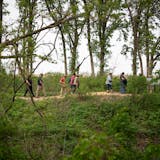Arena Dances addressed the Earth's changing environment with its premiere "Thermal: Meditations on Climate Change" at the American Swedish Institute in February.
Six months later, the company presented the work outdoors in the hot August air at the Minnesota Landscape Arboretum in Chaska. The change in season between that earlier iteration and the most recent one provided an apropos contrast for a work that laments the impact climate change has on the living things that inhabit the planet.
Three dancers endured a desolate landscape in a world created by choreographer Mathew Janczewski. (At the arboretum, Dustin Haug, Javan Mngrezzo and Betsy Schaefer Roob performed the roles. Mngrezzo and Schaefer Roob took over for original cast members Rachel Clark and José A. Luis.)
The sounds of bugs, a distant lawn mower and cars from a nearby highway Sunday evening added to the soundscape by Joshua Clausen, which encompassed ominous rumbling noises, cinematic orchestral music, squeaks and sounds of static.
The dancers seemed to be travelers forced to migrate because of the changing landscape and climate. Whether they were humans, creatures of some sort or flora (spoken text by the performers referenced seeds and plants), they appeared to shift among those identities and states.
Janczewski, who has led Arena Dances since founding the company more than 25 years ago, employs an expressiveness and engaging use of tension and release. His dances, even when exploring difficult topics, highlight an element of beauty and compassion. His gentle choreography in "Thermal" provided an experience to marvel at the human body and all it is capable of. There's acrobatic athleticism in Janczewski's work as well as a gentle interplay of torsos, limbs and skin.
The abstract nature of the choreography and design also leaned toward an open interpretation of who the travelers represented precisely. With a fluidity of movement, open-hearted presence and a cohesion of bodies moving as one, the dancers journeyed together, finding resilience through their reliance on one another.
Janczewski employed quite a bit of weight-sharing in the choreography, and found a balance between simultaneous movement, solo and duet sections, and divergent patterns performed in connectivity with the three dancers. The movers always felt like they were part of the same entity, facing the extremes of the environment together.
![Three weeks ago, Octavio Rodriguez switched from making transmission parts to casting parts for hospital bed brake assemblies at Twin City Die Castings. ] GLEN STUBBE • glen.stubbe@startribune.com Thursday, April 9, 2020 How employee-owned Twin City Die Casting, which just laid off 40 production workers of its 250 employees in what was supposed to be a good year, is trying to accelerate its pivot to growing medical parts business for ventilators, hospital beds, etc as it copes with instan](https://arc.stimg.co/startribunemedia/WNZYKGTZ5IYMUCO3KI5TR3N7WI.jpg?&w=80&ar=1:1&fit=crop)
djoles@startribune.com As boaters flock to Minnesota lakes and rivers this holiday weekend for the unofficial kick-off to the boating season, they'll face more inspections in and out of the water as local cities and counties ramp up their work to stop the spread of invasive species. Across the metro, more boat accesses will be staffed by watercraft inspectors thanks to $10 million funneled to county government programs this year, up from $4.5 million the state allocated last year. ORG XMIT: MIN1505222156290209 ORG XMIT: MIN1506021218440580](https://arc.stimg.co/startribunemedia/34QSKO44B2XKVNUZCO5SLJQSLY.jpg?&w=80&ar=1:1&fit=crop)

